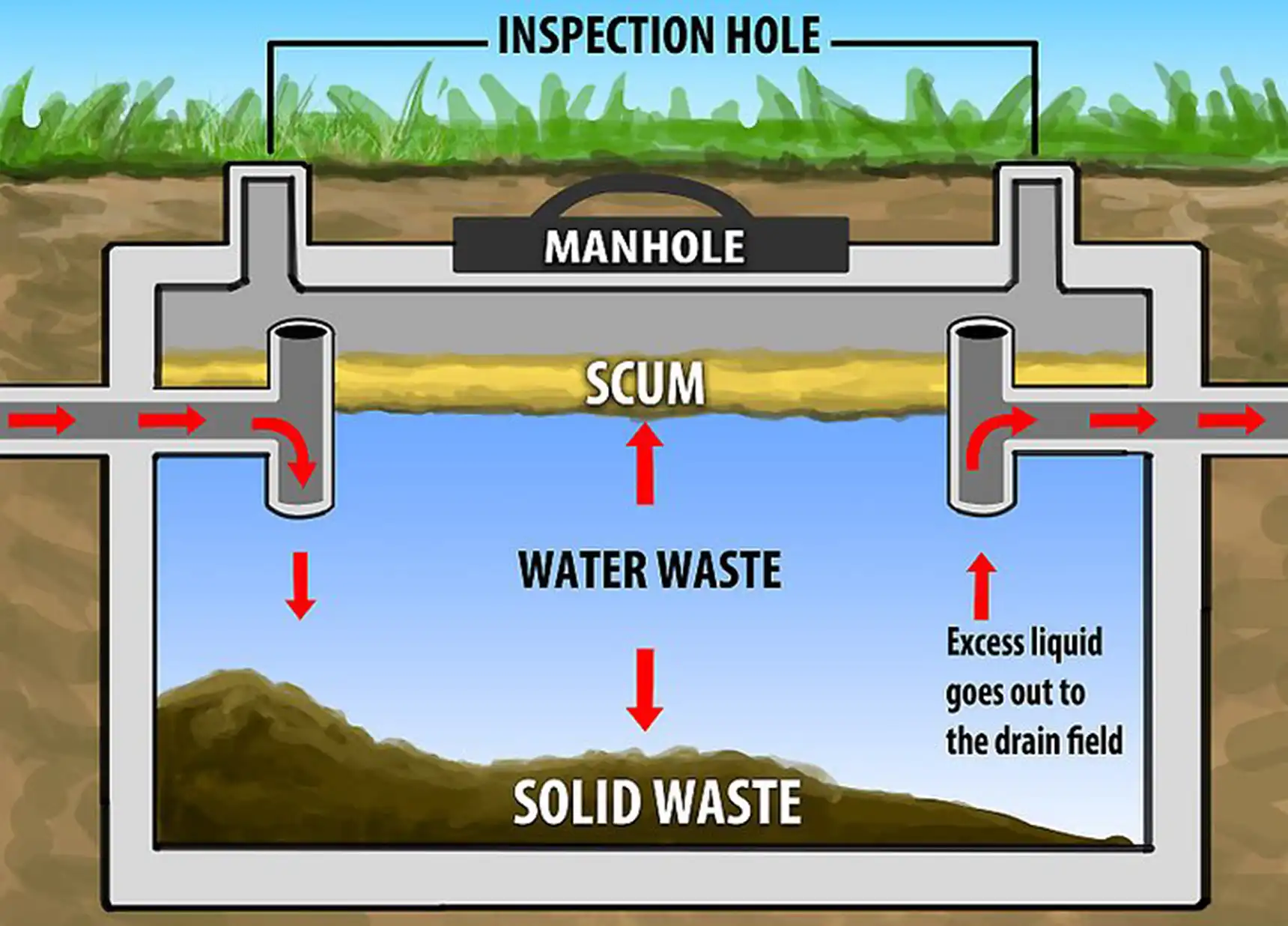
Septic Systems - Tips on Managing Your Wastewater
Updated
Published
The Scoop on Septic Systems
If there’s one thing everyone loves talking about (not really), it’s the nitty-gritty of septic tanks. In Ogden Valley and other rural locations, it’s a very real part of life and one that homeowners have to deal with every three to five years when it’s time to address possible service issues with your sewer system. In this blog, we’d like to dig into the issue a little deeper.
For those who are unaware, here are the basics. A septic system is an underground wastewater treatment structure, commonly used in rural areas without centralized sewer systems. These systems use a combination of nature and proven technology to treat wastewater from household plumbing produced by bathrooms, kitchen drains, and laundry.
Usually, a septic system consists of a septic tank and a drain field, soil absorption field or leach field. The septic tank digests organic matter and separates solids from floatable matter, like oils and grease, from the wastewater. Soil-based systems discharge the liquid, known as effluent water, from the septic tank into a series of perforated pipes buried in a leach field, leaching chambers, or other special units designed to slowly release the effluent into the soil or surface water.
Alternative systems use pumps or gravity to help septic tank effluent trickle through sand, organic matter (e.g., peat and sawdust), constructed wetlands, or other media to remove or neutralize pollutants like disease-causing pathogens, nitrogen, phosphorus, and other contaminants. Some alternative systems are designed to evaporate wastewater or disinfect it before it is discharged to the soil or surface waters.
The successful use of your septic system has a lot to do with your individual behaviors, as well as those you share your home with. Being realistic about your habits and knowing how those habits affect your septic system will go a long way in determining what type of care you should expect.
For example, preparing and consuming foods high in fats, grease or oils will most likely result in more frequent service calls than those who prepare and consume less fats and oils. A high water use home will need to calculate their water usage compared to the size of their septic tank to determine if the tank is suitable to accommodate that much water. The type of soil composition in the leach field also has a lot to do with how long your system will last.
For your convenience, we have added a list of seven things to keep on the top of your mind as you effectively manager the use of your septic system. (Cont. below photo)
1. Avoid Items That Clog Pips or Destroy Bacteria
Be careful what you flush or dispose of down the drain. Not all items are “septic friendly” and some things are downright bad for your system. Some things are obvious like plastic items, diapers, feminine hygiene products, condoms or anything other material that doesn’t decompose quickly. The general rule is to stick with human waste and toilet paper. Everything else should be disposed of differently. Some products like baby wipes and cat litter may say they are flushable on the package, but would still present problems for your septic down the road. Harsh chemicals like Drano and bleach are also very bad for the system because they kill off a lot of the good bacteria that is working to consume the bad bacteria in your tank. Always look for septic friendly detergents for washing clothing and dishes.
2. Preventing plumbing back-ups
Hair, too much toilet paper, kids flushing toys down the toilet – these are all things that can clog your pipes. However, one of the biggest culprits is grease. When grease and heavy oils are poured down the drain, it can get stuck in the pipe as it cools down. It’s best to keep these items out of your pipes to help prevent back-ups. If you do experience slowed or stopped drains, try a plumbing snake before resorting to harsh chemicals that could do more harm than good.
3. Laundry Troubles
Septic system drain fields aren't supposed to look like a bubble bath. If your drain field is bubbling, or the septic is backing up into the house, your laundry habits may be the culprit. Using washers that are not water efficient can dramatically increase the amount of water in your septic tank. It’s always wise to space out your laundry habits over several days, rather than staging a weekly laundry marathon on one day. Using liquid detergents is much better on your septic systems because solid or powdered detergents contain filler which can clog up the pores of the soil bed. One of these fillers is bentonite clay, which is also used to plug holes in dams, not exactly the ideal product for a septic system. Another helpful tip is to use washers with a lint filter. When lint gets into your tank, it usually flows right through to your drain field and gets stuck in the soil, causing it to drain more slowly and eventually not at all. When this happens, it’s best to call in a professional to remedy the problem.
4. What goes in must come out
Most septic professional will recommend pumping out your septic system every three to five years, but depending on the amount of usage and the size of the tank, you may need it pumped more often. It’s important to understand how your daily habits affect you system and make decisions on when to clean your tank. Slow or backed up drains are usually a sign it may be time to make that phone call. Newer septic tanks have inspection holes and clean out holes that are either slightly above ground or close to the surface and may not cost extra for the technician to find. On older systems or those buried deep in the ground, it could be costly to dig deep enough for the inspection and pumping. If your system is older, it may be wise to ask the technician to install an access conduit to the tank in order to more easily accommodate future service calls.
5. Prevent Frozen Pipes
A backed-up septic system in cold weather can be a real problem, especially if you have to dig through frozen ground to find the cause. People often leave a faucet running on a slow drip to prevent house pipes from freezing, but when those small drips go into the outdoor pipes, they can freeze, causing ice to accumulate. It's better to let water drip into a bucket, if possible, and dump the bucket down your drain all at once so it washes through.
6. The Power of Plants
Sometimes when your system hasn’t been working quite right, it might be good to look around at what’s growing around your tank. Large trees will uproot your septic. Some types of trees are aggressive in their search for sources of water, and when planted near your septic system, can do serious damage within a short amount of time. We recommend avoiding trees such as any maples, any willows, any poplars, or any of those species that are aggressive water lovers. As a safe bet, you’re able to plant trees that won’t grow taller than about 20 feet, and these should be planted between drain lines, not near them or directly above them.
On the flip side, there are plants that actually help your septic systems. When planted over your septic drain field, the right plants like Echinacea, can help prevent erosion and expel liquid and nutrients from the soil, allowing the septic system to function more efficiently. If grass bores you, try shallow-rooted herbaceous plants like flowers and ground cover. Planting a vegetable garden could be tempting, but it’s best to talk with a experienced horticulturist for advice based on the type of vegetable and the depth of your drain lines.
7. Monitor the Drain Field
One way to monitor the overall health of your septic system is to take a walk along the drain field. If the ground feels soft and muddy and it hasn't rained recently, you could be in trouble. The main reason for a squishy drain field is that the happy balance of bacteria in your tank has been disrupted. Teenagers are one cause of unhappy bacteria, because of their habit of taking long showers and flooding the system with an overload of water. The result is too much water and not enough bacteria to work through it. As mentioned earlier, strong cleaners and antibacterial soaps can disrupt the system and cause your tank to fill up too quickly, resulting in a soggy drain field and a call to a septic technician.
Similar Articles
Sorry, nothing matches that search.

